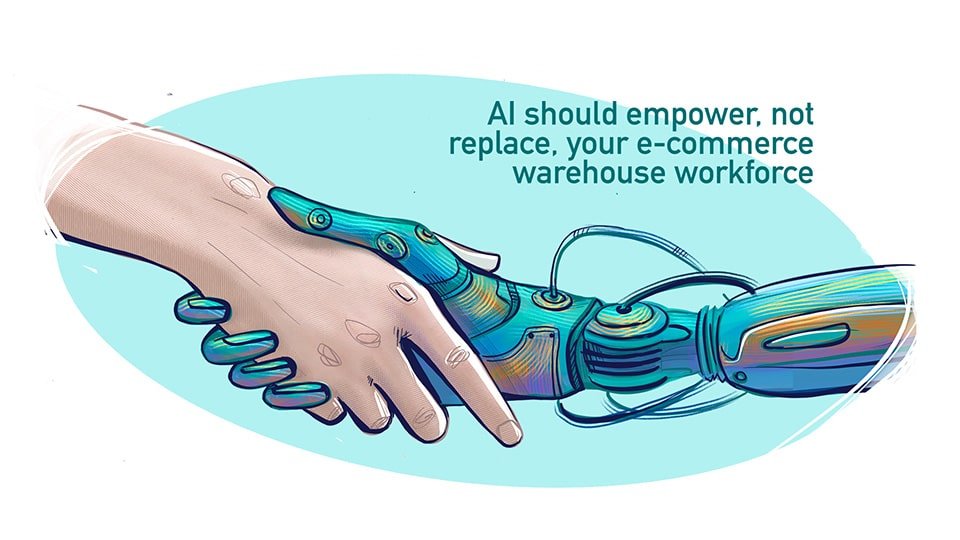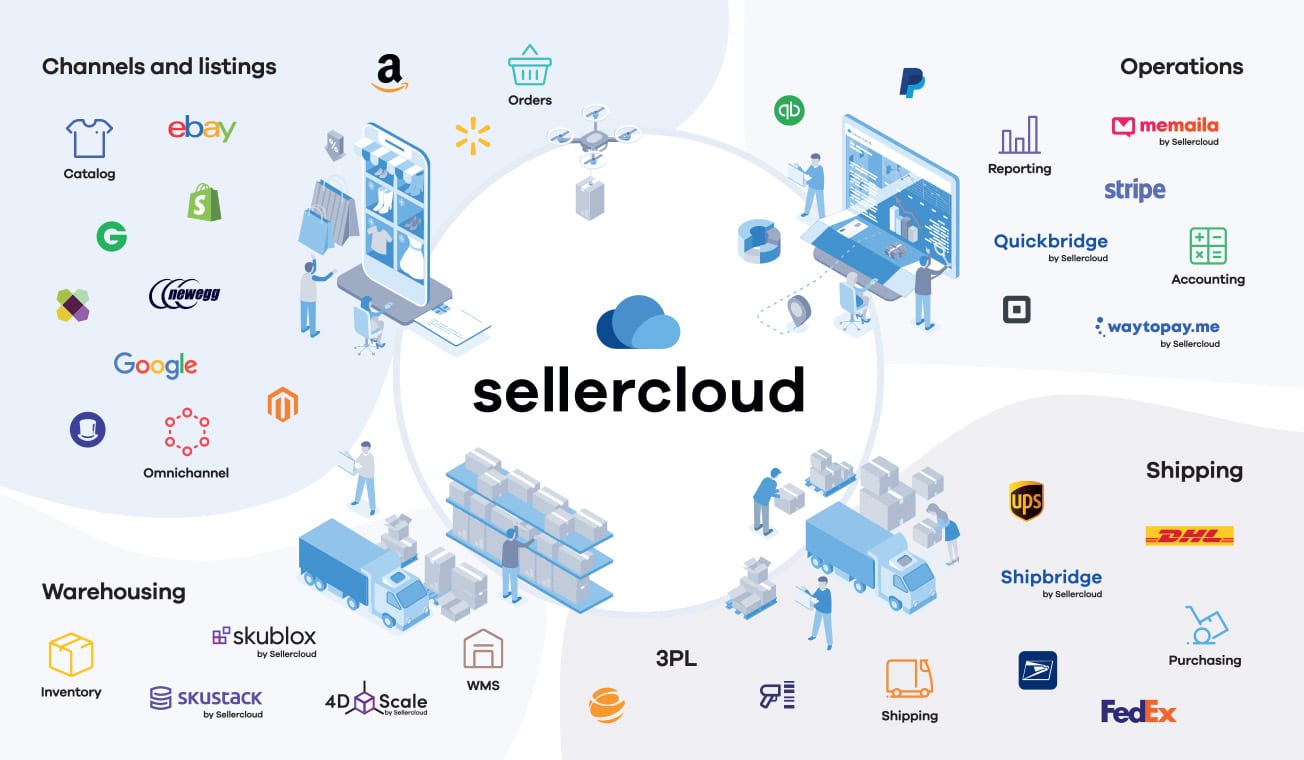Much of the effectiveness and efficiency of an omnichannel e-commerce warehouse depends on how it is configured.
Once you have faced the challenges of finding the perfect location and size for your warehouse, you need to shift your focus to getting the most out of what’s inside.
There are a number of crucial components to running an e-commerce warehouse. What’s more, many of the most critical elements you need to put in place at the outset are so intertwined and interdependent that they cannot be considered in a vacuum; your choices in one area have a direct impact on the optimal solutions in others.

To help you make sense of this decision-making process, we have compiled this handy guide to steer you through the questions and details you need to get right to be sure that your e-commerce warehouse runs smoothly.
Layout
Design your warehouse for maximum flow, safety, and usefulness
Depending upon your workflow and the physical constraints of your warehouse building itself, there are a number of possible designs for creating the most logical pathways for your goods, equipment, and staff.
Identify Your Required Warehouse Elements
Naturally, you need to start by identifying the areas in which your e-commerce warehouse will need to function.
Typically this would include:
- Inventory Storage — Using metrics like the inventory turnover formula and other business intelligence (BI) data points, you should have an idea of how much space you will need to dedicate to the bins and racks that will store your stock and merchandise. This will likely be one of the largest dedicated spaces in your warehouse.
- Receiving — Most warehouses have a space allocated to the reception of stock and inventory. This space needs to be accessible via some type of loading dock or other building entrance.
- Shipping — While some warehouses are designed to share space between shipping and receiving (more on this later), most businesses opt to have a separate exit point established for stock and orders to leave the warehouse.


- Picking and Packing — Before your items can be shipped, orders need to be retrieved from inventory storage and packed efficiently. This requires room for products and cartons as well as accessible pathways for your warehouse team to use.
- Office Space — In most cases, you will need at least some warehouse space reserved for clerical and management staff.
Choose the Ideal Warehouse Configuration
Every warehouse is unique, and as a result, so is every warehouse design.
However, there are some standard configurations that are generally accepted as industry best practices. Each is named for the letter that best mimics the flow of goods through the building. In most cases, the physical characteristics of your warehouse’s construction will dictate the natural layout for your e-commerce workflows.
- I-Shaped and L-Shaped Flows — These are the ideal layouts for warehouses with loading docks on different sides of their buildings. Reception is at one end, flowing into inventory storage, picking and packing space, and eventually shipping at the other end. Since products are flowing in a one-way trajectory, this is sometimes referred to as a through-flow warehouse configuration.
- U-Shaped Flow — Many warehouses only have loading docks on one side of the building. In these cases, inventory must flow in a horseshoe pattern from reception, into storage, out for picking and packing, and back to the dock area for shipping. While this does offer some advantages over through-flow designs – namely, the ability to share staff and technology between receiving and shipping – it can also lead to productivity logjams.
It is critical in a U-shaped product flow to clear loading docks quickly as not to hold up either the front– or back-end of the fulfillment workflow. It is also important to establish physical boundaries and routines to prevent confusion between goods coming in and goods heading out.
Consider Your Inventory Storage Flexibility Needs
Within your warehouse’s inventory storage, you need to have a prioritization plan to ensure that your highest-moving inventory is the most accessible to your picking and packing teams. Similarly, you need workflows in place for cycling seasonal merchandise, identifying and removing dead stock, and processing returned products. As such, your storage area cannot simply be designed based on organizing as much merchandise into the space as possible; it also must have the space and flexibility for people and goods to move safely as merchandise is continually assessed and reconfigured based on need.

Utilize Warehouse Visualization Technologies
Arranging equipment and stock in a warehouse is a big job.
Warehouse visualization software can be a useful way to experiment with different ways of utilizing your physical space before actually committing to a layout. Some of these programs also include options like virtual reality (VR) or augmented reality (AR) modeling so that you can use tech to experience the scope of your design first hand.
If you are considering automation options for your e-commerce warehouse, creating and maintaining accurate warehouse visualizations moves from a convenience to a necessity. Most automated vehicles and sorting technologies rely on these digital maps of your warehouse to move safely and perform tasks efficiently.

Technology
Streamline your warehouse workflows with the right powerful and accessible technologies
The technology that you choose to run your warehouse almost has to be considered in tandem with your layout – particularly in your most active areas like receiving, processing, packing, shipping, and office space. Selecting the right tools also means creating the proper infrastructure and physical flow to be able to maximize their benefit.
Warehouse Management System (WMS)
A dependable, versatile WMS is the heart of an omnichannel e-commerce warehouse workflow.
Most WMS options are marketed as software as a service (SaaS) products and serve multiple functions that are vital to keeping your warehouse running smoothly.
Some of the most important aspects of an omnichannel e-commerce WMS include:

- Inventory management — One of the greatest benefits of an effective WMS is the ability to locate, track, and move inventory with speed and efficiency. Not only can you tabulate inventory and stock levels, but you can help ensure that the materials and merchandise you need end up in the right places at the right times by tracking the movement of bulk shipments and individual items as they move between multiple locations.
- Supply chain management — A WMS can provide invaluable data about the stock levels you need to produce your products and fulfill your orders. Opting for a WMS that offers predictive purchasing can automate this process to ensure that you are never left shorthanded.
- Order fulfillment — A WMS can be used to conduct all of the processes involved in fulfilling omnichannel e-commerce orders. It can even control workflow tools like pack-to-light systems and multidimensional scales to optimize packing and shipping procedures so that customers receive their orders quickly and cost-effectively.
- Data tracking — A WMS should surface the data you need to both optimize and assess your warehouse performance. These reporting features should include critical information like transaction details, tax information, shipping costs, return rates, and profit and loss (P&L) data.
- Return management — The RMA process is a unique workflow that, if not given proper attention, could lead to wasted time, space, and profitability in your warehouse. A WMS should give you the ability to accept and process returns accurately and promptly.
- Practicality — Even the most feature-rich WMS won’t do much for your warehouse if its tools and interfaces are too complex and bloated for your team to use effectively. You need to be sure that you are opting for a WMS that both matches your e-commerce business needs and supercharges the efficiency of your warehouse workforce.
- Accessibility — Even if a WMS has exactly the features your brand and warehouse require, it is all moot if the learning curve for adoption and implementation is too steep. When selecting the ideal WMS, you must consider the end user experience and the amount of training and support your teams will need to be able to extract the maximum value from its use.

Given the time and expense associated with onboarding new staff, the more complicated the training is on your warehouse technology, the longer it will take to get new hires (and those tasked with training them) on task. Furthermore, employee turnover is common in warehouse environments, so the more intuitive and familiar your technology is to your teams, the easier it will be to bring new members on and quickly maximize their potential. The right WMS can go a long way in reducing the time, cost, and frustration associated with your warehouse staffing processes.
Pack-to-Light Systems
Reducing errors must be a priority for any omnichannel e-commerce brand looking to stay in the good graces of its marketplace partners and customers.
Pack-to-light systems help warehouse teams reduce costly picking, packing, and shipping errors by ensuring that the right items end up in the right cartons with the correct shipping labels every time. The result is a packing and shipping department that is both faster and more accurate.
Packing Optimization Tools
The right technology can take the guesswork out of how to most efficiently pack outbound e-commerce orders. Multidimensional product scales and on-demand packaging systems can streamline elements of the cartonization process, save your team time, and cut down on wasted shipping costs.

Warehouse Wiring and Infrastructure
As you consider the technological needs of your warehouse, be sure to maintain a focus on the infrastructure required to make it all run. With each new technological addition to your setup, do not neglect the physical, power, and networking needs of each component.
Scalability
Keep an eye toward the future with growth-focused warehouse decisions
For all of the aforementioned warehouse design and management decisions, you need to consider how easily they could be scaled to match changes and evolutions in your e-commerce business’s future. This could apply to everything from seasonal demand spikes to brand growth. Is your warehouse agile enough to adapt in the ways you know it will need to? What about the unexpected ways? Ecommerce is a constantly evolving industry that requires constant oversight and adjustment. Your warehouse protocols must be up to the task.
Once again, the centerpiece of an ideal e-commerce warehouse workflow must be a scalable and responsive warehouse management system (WMS). The dynamic nature of the online retail industry means that not only do you need the ability to interface with all of your omnichannel marketplace, logistics, and fulfillment partners, but you also must have the support system in place for continuously improving and adjusting your warehouse workflows to best suit your needs both now and into the future.

Sellercloud’s family of products are here to deliver you the technology and tools your warehouse needs to get up and running, and the scalability to grow your omnichannel e-commerce brand.
- Sellercloud’s cloud-based platform allows you to coordinate your entire omnichannel e-commerce business across multiple teams and locations so that every aspect of your brand runs smoothly and reliably – from your headquarters to your warehouse to your customers’ doorsteps.
- Sellercloud’s patented WMS solution, Skustack, gives you industry-leading inventory visibility over the entire lifecycle of your merchandise. What’s more, its intuitive tools and interface improve warehouse efficiency while simultaneously reducing staff-training time.
- Sellercloud’s put-to-light pack-to-light system, Skublox, transforms your shipping department with an intuitive order-processing system that is both scalable and affordable.
When it comes time to design your own e-commerce warehouse, trust Sellercloud to provide the technological and data-driven backbone of your operations.
Contact us today to request a demo and see for yourself how our platform and tools are the ideal partner to grow your omnichannel brand.
